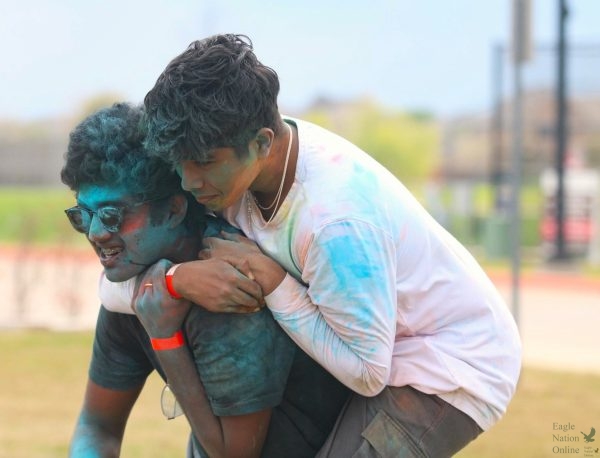Column: the history of St. Patrick’s Day, more than green
Sitting atop a dinner table, St.Patrick’s Day decorations display the colorful excitement brought about by the holiday. St. Patrick’s Day is celebrated every year on March 17. The most common symbols of St.Patrick’s Day pictured in the photo are shamrocks, gold coins and a leprechaun.
March 16, 2021
When walking down the school hallways in America on March 17, it is not uncommon to see a wave of people dressed in green, or witnessing people pinch those who aren’t. These are just two traditions of people who celebrate St. Patrick’s Day, but many people don’t know anything about this holiday beyond little bearded leprechauns and wearing green.
Growing up, my family enjoyed participating in this holiday by eating lucky charms and watching the 1959 Walt Disney movie: Darby O’Gill And The Little People, a story about an old Irish man, his daughter, and their experiences with the king of the leprechauns. Although people today celebrate St.Patrick’s Day mostly as an excuse to wear green or go to a pub, the true reason for this holiday is to honor St. Patrick, the patron saint of Ireland who died on March 17, 461 A.D.
Born in Roman Britain, St. Patrick was kidnapped and taken to Ireland at the age of 16. He was enslaved for six years after which he escaped, returned to England, and entered the clergy of the Catholic church.
View this post on Instagram
In the year 432 A.D., St. Patrick returned to Ireland as a missionary. St.Patrick is revered by the Irish people because he is credited with spreading Christianity to Ireland. As of 2016, Christianity made up 84.6% of the religious makeup of Ireland.
The first known celebrations of this holiday were in the ninth and tenth centuries but the holiday was called St. Patrick’s Feast Day. “Feast Days” in the Catholic liturgical calendar don’t necessarily mean that they have a big meal, they are just days allotted to honor different Saints throughout the year.
To give some perspective, this holiday has gone on since Vikings were still participating in conquests across Europe, and the medieval age was in full gear. Women wore giant, ‘V’-shaped hats, courts had jesters and carrying a sword with chainmail wasn’t unusual attire either.
The early 1600s brought more legitimization to the holiday when it became a holy day of obligation for Roman Catholics in Ireland. A holy day of obligation is a day in which Roman Catholics are expected to attend mass and take a day off of work and recreational activities.
I’m not Catholic, but if I was, I would not protest to celebrating several holy days of obligation. Spending multiple days a year eating and relaxing to honor a saint instead of going to work or school sounds great to me.
View this post on Instagram
St. Patrick’s day did not become an official public holiday in Ireland until 1903 with the passing of the Bank Holiday (Ireland) Act. The first St. Patrick’s day parade was held this same year on March 15 in Waterford, Ireland.
On St. Patrick’s day in 1916, while World War I raged on the Irish Volunteers, an Irish nationalist group, organized 38 parades across Ireland involving thousands of armed men. These parades were the prelude to the Irish revolution and the Irish civil war. The holiday ceased to be celebrated in public events from 1919 to 1923 except for the purpose of political rallies due to the political and social tension.
After this period of unrest, the holiday began to become widely celebrated once again.
In the past, there were disputes between Irish Catholics and Irish Protestants about the celebration of St. Patrick’s day and who should be able to participate in celebrations. Although St. Patrick is a catholic saint, St.Patrick’s day is also a feast day in the Church of Ireland which is a prominent sect of the Anglican church.
This religious conflict over the holiday led to it being less widely celebrated in Ireland during the 1960s-1990s and the celebrations generally only took place in Catholic communities. Throughout this period of time, there were several incidents increasing tensions between religious groups such as bombings of Catholics on St.Patrick’s Day, and Protestants attempting to reclaim the holiday by throwing their own parades.
The ending of decades of conflicts is largely connected with the efforts of the Irish government in the mid-90s to use St.Patrick’s Day to celebrate Ireland and its culture. The first Festival of St. Patrick’s Day was held in 1996, it was so successful that the next year it became a three-day event. Disputes ended entirely in 1998 when cross-religious community parades celebrating St. Patrick’s Day began to become a tradition.
Despite St. Patrick’s Day being a holiday that originated in Ireland, it is celebrated by people of Irish descent or not all over the globe.
In my family, we are all very focused on knowing where we come from and who paved the way for us to be where we are now. Being of Irish descent, celebrating St. Patrick’s Day has become a way for me to feel connected to my ancestors and have fun at the same time.
In the U.S., St. Patrick’s Day has been celebrated since 1601, and has hosted several large parades and events in its cities over the course of the centuries. Chicago, Illinois is the most commonly known place to celebrate the holiday in the U.S., largely due to its famous act of dyeing the Chicago River green along with a grand parade.
Happy St. Patrick's Day Weekend, Chicago! ☘️
Although we didn’t gather, we were able to honor long-standing tradition by dyeing the Chicago River green, thanks to the Chicago Journeymen Plumbers. If you're heading out today, make sure to mask up and watch your distance. pic.twitter.com/UfU2GI74nC— Archived: Mayor Lori E. Lightfoot (@mayorlightfoot) March 13, 2021
View this post on Instagram
In Canada, Montreal hosts one of the largest St.Patrick’s Day parades every year since 1824. In Saint John, New Brunswick, St. Patrick’s Day is an entire week worth of celebrations. Although it is not a national holiday, there are still dozens of cities and towns across Canada that continue to celebrate the holiday.
In England, members of the royal family gift a bowl of shamrocks to the Irish Guards, maintaining the tradition that was begun in 1901 by Queen Alexandra. Since 2012, the role of gifting has fallen to Catherine, the Duchess of Cambridge. Despite past conflicts between England and Ireland, English citizens have overcome this, and now wear a shamrock on their clothes on St. Patrick’s Day to show support of the Irish.
This year, I have already started to celebrate St. Patrick’s Day by listening to Irish music, educating myself about the holiday and sporting shamrocks on my car and clothing. On the actual holiday, I plan to watch our usual family movie, wear lots of green and tackily eat lucky charms for breakfast.
Presently, St.Patrick’s is a holiday for anyone in and out of Ireland and is a celebration of Irish culture that brings people together. The COVID-19 pandemic has led to the cancelation of St.Patrick’s celebrations, parades and traditions across the globe both this year and last, but it is still a holiday that people can come together to celebrate at home.






















Rick Baron • Mar 17, 2021 at 3:22 pm
Very informative article.
I’m happy to see that Prosper High is encouraging their students to seek out interesting stories about our country’s good people (UGR article published in a previous edition) and enlightening articles that educate themselves and others about the origin of our diverse traditions and celebrations.
Keep up the good work.
Christi’s maternal grandpa
Christi Norris • Mar 17, 2021 at 8:56 pm
Thanks for the support Grandpa, it means a lot!
– Christi